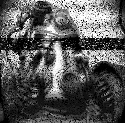|
I'm not really in an either/or situation with regards to the budget.
|
|
|
|

|
| # ? May 24, 2024 17:22 |
|
That looks super overpriced. A $35 DAC will sound good and a $100 DAC will sound good and look nice. Any amp that isn't junk will sound good. I second spending money on speakers.
|
|
|
|
Avian Pneumonia posted:I'm not really in an either/or situation with regards to the budget. So what are you running for speakers? Start there and go backwards.
|
|
|
|
I've sort of inherited a medium-small set of B&W floorstanding speakers that I'm told are 'really good' but I may go in another direction, too.
|
|
|
|
Avian Pneumonia posted:I've sort of inherited a medium-small set of B&W floorstanding speakers that I'm told are 'really good' but I may go in another direction, too. What model are they?
|
|
|
|
Won't know until I pick them up in a few weeks.
|
|
|
|
Avian Pneumonia posted:Won't know until I pick them up in a few weeks. Well I can guarantee you you won't need a $1000 "600wpc" amp to drive them. If you want one that's a different story.
|
|
|
|
That Peachtree is 65 WPC into 8 ohms which may or may not be harmful to your tweeters if you clip that amp by turning it up too loud. B&W speakers are known to be power hungry, so you're probably going to want something 80WPC and above. If you have $1000 to spend you can get something very nice on the used market. If you like how 70s receivers look, then go for something nice there. However, receivers are known to take a hit in terms of audio quality because they have to squeeze a tuner, phono stage, and power amp all in one package. I would instead look for an integrated amp or separate power amp and preamp from the 80s or 90s. Stuff from the 70s is around 40 years old and unless you know your way around electronics is a pain to maintain.
|
|
|
|
Cleaned up that KA-7300 and took a better photo Can't believe what good shape it's in, and it just needed a good cleaning.
|
|
|
|
BANME.sh posted:Cleaned up that KA-7300 and took a better photo gently caress am I jealous.
|
|
|
|
Can a record stylus withstand backcueing? Specifically, the Shure M97xE? I don't scratch records like a DJ, but I sample from my records and lining the record up just right involves a fair bit of backcueing.
|
|
|
|
BANME.sh posted:Cleaned up that KA-7300 and took a better photo Looks sweet
|
|
|
|
BANME.sh posted:Cleaned up that KA-7300 and took a better photo Very nice. Looks perfect.
|
|
|
|
The bigger the volume knob on the integrated amp the better it sounds, it has been proven.
|
|
|
|
Cool NIN Shirt posted:Can a record stylus withstand backcueing? Specifically, the Shure M97xE? I don't scratch records like a DJ, but I sample from my records and lining the record up just right involves a fair bit of backcueing. That stylus is not designed for backcueing. The chances of damaging it are much higher than with cart having a DJ-style suspension.
|
|
|
|
ShotgunWillie posted:That stylus is not designed for backcueing. The chances of damaging it are much higher than with cart having a DJ-style suspension. drat it. Do you have a cartridge you could recommend that is both durable and sounds good?
|
|
|
|
BANME.sh posted:Cleaned up that KA-7300 and took a better photo Dual phono
|
|
|
|
Chill Callahan posted:That Peachtree is 65 WPC into 8 ohms which may or may not be harmful to your tweeters if you clip that amp by turning it up too loud. This is actually (mostly) a myth, which requires further explanation. Too much power is what kills speakers, not too little power. What happens when you overdrive or clip an amp is that the signal starts to act more like square waves than sine waves. Now, as everyone who's ever dealt with synthesizers and tone generators will know, square waves are not automatically damaging. People claim that they are because they contain a lot of DC or near-DC output, but they don't really. Square waves in audio are made up of a fundamental sine overlaid with a number of odd harmonics, so it's not DC at all. And if square or near-square waves were damaging to speakers, every synth band (or guitar amp with distortion) would be blowing speakers left and right. However, what a square wave does have is ~1.4x the RMS voltage and effectively double the power of a sine wave of the same frequency, at the same peak-to-peak voltage. You're putting more power into the voice coils, which can lead to overheating if the speakers are not made to handle that power. So if your speakers are rated to handle 3x or more of what the amp can produce, it is simply impossible to damage the speakers, no matter how wildly you clip the amp. Even if the speakers can only handle 2x of what the amp produces, damage is very unlikely. So if those B&W speakers are rated to handle ~200 watts or above (and they very likely are), that 65wpc amp will never ever be able to damage them by clipping. It may sound like utter poo poo, but the speakers will be fine (if the power handling rating is truthful). Only if the speakers are rated for the same power (or only slightly more) that the amp can produce cleanly, and you then drive it into clipping will damage be likely. But this will still take some time, it will not happen instantly. Instant speaker death only occurs when speakers are deliberately fed significantly more power than they are made to withstand. "Too little power kills speakers" is definitely a myth. "Clipping damages speakers" can be true, but it is not something you have to worry about unless you're pushing pretty high power levels. I guarantee that with a 65wpc amp, you'll only be using maybe 1-10 of those watts, even for relatively loud listening levels. Peaks will use more power, but peaks are very short-term impulses by definition, and most amps can usually deliver almost double the rated power for short bursts. Here's a more indepth look at the issue: http://www.avsforum.com/forum/89-speakers/1233961-speaker-damage-under-powering-clipping-myth.html quote:receivers are known to take a hit in terms of audio quality because they have to squeeze a tuner, phono stage, and power amp all in one package. This one is absolutely a myth, however. Integration does not automatically imply tradeoff. You will probably have to pay a little more for a receiver with similar power levels to a power amp or integrated amp because of the added functionality, but that does not imply a loss in sound quality. If they can deliver the same power, they will perform equally well. Never disregard a good offer on a receiver because you think the tuner and other functionality will hurt the sound quality, because it won't. E: Edited for clarity. KozmoNaut fucked around with this message at 09:54 on Feb 26, 2015 |
|
|
|
Thanks for the info on underpowered amps. In terms of receivers, however, not many high-end audio companies made high-powered recievers. The "monster" recievers of the 70s command huge premiums. I guarantee something like this combo: http://www.ebay.com/itm/Nakamichi-PA-5II-Power-Amp-/161609179549 http://www.ebay.com/itm/NAKAMICHI-CA-5-PREAMPLIFIER-/351325567846 will sound much better that whatever Pioneer SA-1250 or Sansui 9090DB.
|
|
|
|
Chill Callahan posted:Thanks for the info on underpowered amps. I am curious as to how you can guarantee that. Specifically what makes that combo produce better sound than a receiver or even an integrated amp? It's true that if you need monster power, you probably need a dedicated power amp. But very few people actually need that sort of power, so at normal-to-loud volume levels, there is literally no difference. For instance, my parents had an Akai AA-1135 (35wpc), which had absolutely no cleanly problem powering a set of Pioneer HPM-60s to thundering levels, with no distortion or clipping. There was absolutely no reason for them to even consider a more powerful amp. KozmoNaut fucked around with this message at 17:06 on Feb 26, 2015 |
|
|
|
The thing with speakers is that they aren't a static impedance. B&W speakers, especially, need a lot of current. For low bass they can dip down close to 2 ohms. A lot of lower-end receivers can't deal with those kind of impedances and often clip the bass. I have heard TOTL recievers next to stuff like Threshold (what those Nakamichis licensed their tech from) and the Thresholds sound much better in terms of clarity and bass representation. Maybe a 70s receiver completely overhauled will sound similar, but I'm not sure about that.
|
|
|
|
Chill Callahan posted:The thing with speakers is that they aren't a static impedance. B&W speakers, especially, need a lot of current. For low bass they can dip down close to 2 ohms. A lot of lower-end receivers can't deal with those kind of impedances and often clip the bass. Well, then you're talking specifically about low-end receivers, but even stuff like the Akai I mentioned is nowhere near low-end, despite "only" having 35wpc and being a perfectly affordable receiver back then. Nice big power supply is the rule, not the exception for 99,9% of the vintage gear you'll be looking at today. Sticking to vintage gear, you have to find some of the nasty low-end cheap stuff, and hardly any of that can be found anymore because they simply weren't worth keeping or restoring. It's the same thing when people trot out the old chestnut that "music was much better in the old days". No, there was plenty of poo poo back then too, but people only remember (and preserve) the good stuff. As for the listening test, I'm sorry but that just smells terribly of BS, especially since you specifically mention comparing TOTL receivers to separate amps, where the manufacturers would specifically do their very best, radio tuner or no tuner. A sighted, subjective listening test is worth absolutely nothing, especially when you go into it with certain expectations. I know some vintage stuff can have certain sound signatures, because tolerances were looser back then etc., but that has nothing to do with the inclusion of a radio tuner in some designs. The amplifier itself is just an amplifier, no matter what it shares its cabinet with.
|
|
|
|
Some receivers are a total pain in the rear end to work on because of the tuner, though, so if you don't listen to OTA radio it could be a decent reason to go integrated amp.
|
|
|
|
I guess what I'm getting at is that even TOTL receivers are "mid-fi" at best. You'll never see a receiver with a Class A amp (though there's nothing wrong with making one theoretically) and rarely see one with a dual mono topology. Because of public perception (largely outside of the US) of the quality of receivers, manufacturers will always have a separates set or integrated amp that trump their recievers. Pioneer has the SPEC series, Sansui's black-faced pieces etc. Moreover, at the same pricepoint, you will always do better with a separates set or integrated amp. Another point I was driving at was that receivers from the 70s are close to 40 years old. To get one to sound its best you probably need all new capacitors, tuner aligned, etc., and you're going to pay a lot either in time or money to have that done. It's much more cost effective, in terms of maintainability, to get a more recent integrated or separates set from the 80s or 90s. Additionally, 70s recievers and equipment are collectible so a piece in fully restored shape commands a large premium. Things from the 80s and 90s don't have that collectiblity premium attached (at least not as big as things from the 70s). Receivers from the 70s do look nice and I'll give them that.
|
|
|
|
Chill Callahan posted:I guess what I'm getting at is that even TOTL receivers are "mid-fi" at best. You'll never see a receiver with a Class A amp (though there's nothing wrong with making one theoretically) and rarely see one with a dual mono topology. Because of public perception (largely outside of the US) of the quality of receivers, manufacturers will always have a separates set or integrated amp that trump their recievers. Pioneer has the SPEC series, Sansui's black-faced pieces etc. Moreover, at the same pricepoint, you will always do better with a separates set or integrated amp. Class A and dual mono are pointless for audio from any rational point of view, since you can easily make a class AB stereo amp that performs equally well, especially if you know to use forward bias and negative feedback to eliminate crossover distortion. Only crazy-rear end audiophiles labor under the assumption that negative feedback is "bad" for various esoteric reasons. It's true that a class-A amp is a simpler design, but that doesn't automatically make it better. I wouldn't lump integrated amps with pre/power amp sets, they're much closer to receivers in construction. Manufacturers will make pre/power amp sets that "trump" their receivers, at least according to their own marketing materials. They tend to be significantly more expensive than integrated amps or receivers because of lower production runs and because they appeal to "serious listeners" (read: deluded audiophiles). An integrated amp is much close to a receiver with the tuner ripped out, than to a pre/power amp set. Take the NAD C165BEE preamp I'm using because I switched to active speakers. Compared to the C320BEE integrated amp I had before, it's hilariously overbuilt. Custom discrete class-A gain modules, bigger power supply (for all of 20W peak power consumption), case made of thicker metal, individual relays for everything, dedicated headphone amp circuit, the whole thing is built like a tank. It also cost twice as much as the integrated amp from new. Luckily I got an absolutely screaming deal on it used, from an upgrade-crazy audiophile. When just the preamp costs twice as much as an integrated amp, after adding a power amp to match the power output, you're way into four or even five times the price. For a purely academical difference in specs which will never make an audible difference. But let's say that the three options (set/integrated/receiver) are somehow relatively equal in price. If they play equally loud with equally low distortion (within the limits of audibility), what is the downside to the receiver, apart from tech spec wanking? quote:Another point I was driving at was that receivers from the 70s are close to 40 years old. To get one to sound its best you probably need all new capacitors, tuner aligned, etc., and you're going to pay a lot either in time or money to have that done. It's much more cost effective, in terms of maintainability, to get a more recent integrated or separates set from the 80s or 90s. Additionally, 70s recievers and equipment are collectible so a piece in fully restored shape commands a large premium. Things from the 80s and 90s don't have that collectiblity premium attached (at least not as big as things from the 70s). But you would have the exact same problems with pre/power amp sets that are 40 years old. Conversely, you would also get much better bang for your buck with an integrated amp or receiver from the 80s or 90s than with a pre/power amp set of similar vintage. You can't just directly compare 40 year old hardware of one type with 20 year old hardware of a different type and draw any kind of meaningful conclusion. My point is that it's not worth it to only look at one type of setup (pre/power amp set), when there is great sound quality and screaming deals to be had on integrated amps or receivers, especially since people labor under the misconception that receivers somehow sound "worse", which simply isn't true as a blanket statement. quote:Receivers from the 70s do look nice and I'll give them that. We can definitely agree on that. Wood and brushed aluminum needs to make a comeback.
|
|
|
|
KozmoNaut posted:you would also get much better bang for your buck with an integrated amp from the 80s or 90s Yeah, exactly the point I was making. There's no reason to get a receiver from the 70s other than aesthetics. (edit: or if its a pricepoint below like $1-200) Chill Callahan fucked around with this message at 17:30 on Feb 27, 2015 |
|
|
|
I've been messing with that Pioneer PL-A35 I got and I can't figure out the speed problem. If it sits unused for 12+ hours, it will start off pretty slow and take a minute or two to speed to up full speed, and then it runs very steady. If I want to play a 33, I just run it at 45rpm for ten seconds and then drop the speed down, and that is usually enough to bring it up to the right speed. I tried putting a few drops of 10w30 synthetic motor oil in the two motor lubrication holes, as well as in the spindle, but it doesn't seem to have made a difference. I know the belt on these is often the cause of speed problems, but this one already has a new-ish belt and the speed is really solid once it gets going, so I don't think it's slipping or anything.
|
|
|
|
Remove the belt and manually spin the platter. A well lubed platter should spin freely for 45 seconds to a minute or longer, depending on how hard you spin it. If that's not an issue, then it could be the speed select switch that needs cleaning. Spray some contact cleaner inside it and move it back and forth a couple dozen times. Repeat if necessary.
|
|
|
|
Chill Callahan posted:Yeah, exactly the point I was making. There's no reason to get a receiver from the 70s other than aesthetics. (edit: or if its a pricepoint below like $1-200) An integrated amp or a receiver, is what I meant. It depends on what you can get for how much money. Don't turn down a receiver just because you mistakenly think it'll sound worse.
|
|
|
|
On the topic of "monster receivers": I'm thinking of replacing the HPM-900s that are currently paired with my Yamaha CR-2040. The Pioneers are a blast to listen to and I love the "West Coast" sound, but they're not exactly "Hi Fi" in the pure sense of the term. They also sound better and more interesting when played out of my 35 WPC Pioneer SX-690 so I'm gonna put them together and make that a secondary setup (seriously, the sound signatures of the two combined is just so rich and velvety- almost like a tube setup. It's clear that they were made by the same company for each other and I haven't noticed any issues with dynamics and power). The Yammy is really transparent and natural in its sound profile and it's got gobs of power (120 WPC RMS into 8 ohms, 140 rated dynamic, and a nice big power supply)- so naturally I've been thinking of power hungry "audiophile" speakers that would give me a different experience from the creamy and aggressive West Coast Pioneer sound). In the interest of diversity I'd rather go with something new than more vintage gear and I definitely like weird or cool looking if possible. I've been interested in the new B&W 683 S2's (neither weird nor particularly striking looking but I just dig B&Ws) but then I got to thinking- what about Maggies? TLDR: Would trying to run a pair of Magnepan 1.7i from my CR-2040 be a stupid decision? Would it kill my big strong receiver? Would it sound like rear end? Also, any suggestions for alternative 3-way floorstanders that cost $2500/pair or less would be welcome.
|
|
|
|
KozmoNaut posted:An integrated amp or a receiver, is what I meant. Past the 70s (for the most part), receivers took a huge hit in quality. They started to be more and more geared towards video processing, surround sound, and power. A low THD and large wattage doesn't always mean a reciever will sound good.
|
|
|
|
Chill Callahan posted:A low THD and large wattage doesn't always mean a reciever will sound good. Along with a flat frequency response, it's a very good indication that it is likely to sound like nothing at all, which is the whole point of a good amplifier; to amplify without changing the sound. Features and integration are not automatically bad things. What makes you think the addition of a tuner etc. will harm the sound?
|
|
|
|
The Yamaha manual doesn't specify the power rating into 4 ohms, so I would be careful with the Magnepans. They say they have a free 30-day in-home trial so maybe try that? It should be enough power for B&Ws. I would look for some vintage 804s.
|
|
|
|
KozmoNaut posted:Along with a flat frequency response, it's a very good indication that it is likely to sound like nothing at all, which is the whole point of a good amplifier; to amplify without changing the sound. I don't really feel like continuing the argument lol. I think we can agree that in terms of cost, if there is no tuner, digital processor, etc., more money can be allocated towards high-quality 2-channel reproduction.
|
|
|
|
Chill Callahan posted:I don't really feel like continuing the argument lol. I think we can agree that in terms of cost, if there is no tuner, digital processor, etc., more money can be allocated towards high-quality 2-channel reproduction. Well yes, but building good quality amplification is actually surprisingly inexpensive, despite what manufacturers of expensive equipment will tell you. Economies of scale and a lot of computer money invested in improving electronic components really pays off everywhere. Besides, we were discussing used gear, where you can usually get screaming deals on receivers (stereo or AV), because of the misconception that they sound bad.
|
|
|
|
BANME.sh posted:Remove the belt and manually spin the platter. A well lubed platter should spin freely for 45 seconds to a minute or longer, depending on how hard you spin it. Ok yeah, that definitely doesn't happen with mine. I guess I'll see if there's a way to pull the spindle apart or something to get directly to the bearing. And maybe clean out some of the old grease that's all over it.
|
|
|
|
gently caress accuracy in audio equipment. I flip the loudness switch on and crank the bass and treble to 11 on my power sucking 1970s receivers all day. That KA-7300 I posted a while back there consumes 450W 
|
|
|
|
KozmoNaut posted:Along with a flat frequency response, it's a very good indication that it is likely to sound like nothing at all, which is the whole point of a good amplifier; to amplify without changing the sound. I don't know that you can blanket statement that. People look for different things in amps. Some of my favorite albums that I had listened to over and over and worn the tapes down to nothing sounded lifeless and sterile when I finally upgraded to CD. I liked the dirty, tinny sound from the cassette I was used to. I don't see any reason why an amp that colors the signal can't be said to be improving on what's there if it sounds good. BANME.sh posted:gently caress accuracy in audio equipment. I flip the loudness switch on and crank the bass and treble to 11 on my power sucking 1970s receivers all day. That KA-7300 I posted a while back there consumes 450W or this
|
|
|
|
BigFactory posted:I don't see any reason why an amp that colors the signal can't be said to be improving on what's there if it sounds good. That particular coloration would only be pleading on some content, and annoying on other content. Or completely misplaced on some speakers. If an amp actively colors the signal, it's a lovely amp. EQ has no place built in to an amp. I turn up the bass when I watch movies to give my subs a little extra to work with. But I want to control that myself, it shouldn't be built in to the amp. And if amps really sounded different, why does it seem to be impossible to tell them apart blindly, provided that both amps are built correctly and aren't distorting? For instance: http://matrixhifi.com/ENG_contenedor_ppec.htm KozmoNaut fucked around with this message at 07:12 on Feb 28, 2015 |
|
|
|

|
| # ? May 24, 2024 17:22 |
|
A little bit of distortion sounds gnarly when you're listening to music.
|
|
|














